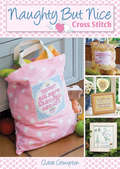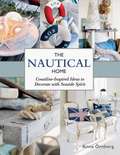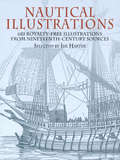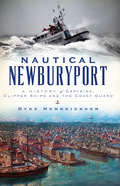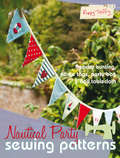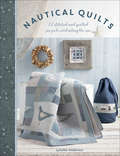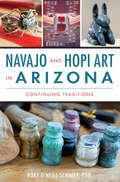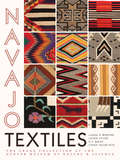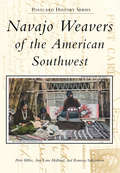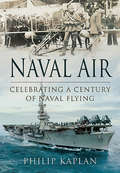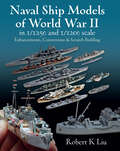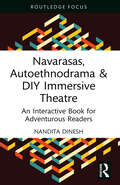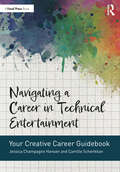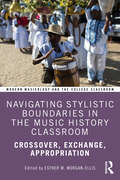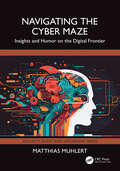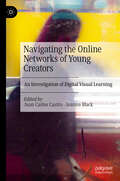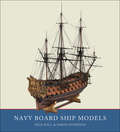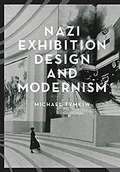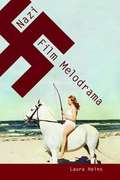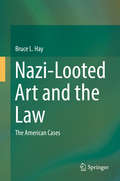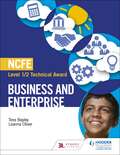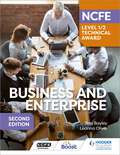- Table View
- List View
Naughty But Nice Cross Stitch: Over 50 Designs To Stitch It Like It Is
by Claire CromptonSay no to sweet sayings! From aging disgracefully to Christmas chaos, these projects put the &“cross&” in cross stitch. Naughty but Nice Cross Stitch features a collection of fifty fun and sassy cross stitch sayings to remind you not to take life so seriously. Each themed chapter presents the ideal answer to the endless demands on a woman&’s time—husbands, chores, children and work. Whatever the crisis, these witticisms are sure to put a smile on your face! A great selection of project ideas accompany the sayings—from hanging signs to framed pictures and cell phone covers—so that you can share the fun with family and friends. &“Perfect for the sassy crafter, simple images with comical phrases which make perfect cards and presents for that person in your life who enjoys a laugh.&” —Baking and Making in Bristol &“Chock a block full of fun patterns this book will give you a chuckle.&” —Trish Alan Designs
The Nautical Home: Coastline-Inspired Ideas to Decorate with Seaside Spirit
by Anna OrnbergAre you a beach bum, a beach lover, or simply just a fan of the water? If you find yourself constantly longing for a relaxing vacation along the sandy shores of Tahiti or yearning to go on a coast-to-coast cruise, look no further. Interior designer Anna Örnberg has all the solutions to bring the waves to your home and living room. With Anna’s advice and expertise, you can turn your own apartment or living space into a beautiful waterfront home. Live on the beach with nautical style and enjoy the waves. Using seashells, ropes, dark woods, and light-colored walls, the interior designs in this book remind readers of sunken ships and buried treasures. The decor will inspire homeowners to personalize their homes into the most calming and soothing living quarters, a place where they can sit, relax, and enjoy the ocean breeze. Projects include: Wooden lampshades Nautical placemats and pot holders Building your own lighthouse Beanbags and pillowcases The nautical look is a classic theme that suits a wide audience. Whether you’re looking for new ideas to spruce up your city center apartment or looking to decorate your holiday vacation home, this book has the answers. The Nautical Home has a little something for everyone, from the average homeowner hoping to reinvent a room or more to the recent college grad looking for new ways to decorate a new home. With the interior designs in this book, you can finally be the captain of your own ship or home.
Nautical Illustrations: 681 Royalty-Free Illustrations from Nineteenth-Century Sources (Dover Pictorial Archive)
by Jim HarterWhile this book is intended is intended for all who love boats, ships, history, and nautical lore, it is also designed as a definitive source of high-quality, royalty-free images for use by artists, graphic designers, desktop publishers, ad agencies, and more. This collection of 681 wood engravings includes striking examples of some of the world's most beautiful boats and ships. Among the many famous vessels in this volume are Columbus's ships, the Nina, Pinta, and Santa Maria; King Henry's VIII's Great Harry; the Pilgrim Fathers' Mayflower; Henry Hudson's Half Moon; King Charles I's Sovereign of the Seas; Captain Cook's Discovery; the HMS Bellerophon; Fulton's Clermont; and the Great Eastern. Among famous naval battles shown are the conflict at Actium, the invasion of the Spanish Armada, Dutch-English engagements in the 17th century, Anson's Centurion capturing a Spanish treasure ship, Nelson's victory at Trafalgar, Perry's triumph at Lake Erie, and the Civil War ironclad contest between the Monitor and the Merrimac. This volume includes a wide variety of vessels: rowboats, funeral barges, Venetian gondolas, catamarans, Native American canoes, Chinese junks, tugboats, canal boats, barges, yachts, brigs, barks, sloops, skiffs, catboats, various kinds of vessels used for fishing and whaling, ships in distress, and more. There are also examples of nautically related material: navigational instruments, diving suits and helmets, lighthouses, canal locks, dry docks, the Suez Canal, helmsmen, ship captains, seamen at work, deck scenes, and interiors of boats. taken from rare sources — depict primitive canoes, a Roman galley, ship figureheads, naval battles, dock scenes, lighthouses, pirate ships, steam-powered battleships, and a wealth of other subjects. Brief captions identify pictures, which are arranged chronologically. Features over 600 black-and-white illustrations from rare sources, arranged chronologically.
Nautical Newburyport: A History of Captains, Clipper Ships and the Coast Guard (American Chronicles)
by Dyke HendricksonNewburyport was once the most dangerous harbor on the East Coast and one of its most prosperous. Local captains and sailors led the nation to battle during the American Revolution and founded the U.S. Coast Guard. They sent vessels to Bombay, the gold rush and the farthest reaches of the world. Author Dyke Hendrickson explores the perfection of the clipper ship, the city’s famous Federalist mansions and the bold adventures from the Age of Sail. Follow the men and women of Newburyport into battle, into gales and into fortune—or ruin.
Nautical Party Sewing Patterns
by Poppy TreffryGet creative with your sewing machine and learn the secrets of freehand machine embroidery with this beautiful selection of nautical sewing patterns.Poppy Treffry shares her design ideas and top tips for getting the most from your sewing machine. Make fun and original gifts for friends and family using these quick and easy techniques. Put your stash of scraps to good use with these contemporary project ideas.
Nautical Quilts: 12 Stitched and Quilted Projects Celebrating the Sea
by Lynette AndersonA brand new collection of beautiful quilted and stitched projects by internationally-renowned designer, Lynette Anderson. Lynette brings her distinctive style of patchwork mixed with exquisite hand embroidery and applique to the theme of nautical quilts. This subject was inspired by her own family history and her grandfather's career in the navy, giving it a very personal flavour. This collection of projects celebrating the sea includes large and small quilted projects so there is something for everyone. Choose from full-sized quilts, wall hangings, a needlework roll, pillows, bags and wall hangings, all illustrated with step-by-step artworks and instructions.
Navajo and Hopi Art in Arizona: Continuing Traditions
by Rory O'Neill SchmittArizona's Navajo and Hopi cultures span multiple generations, and their descendants continue to honor customs from thousands of years ago. Contemporary artists like Hopi katsina doll carver Manuel Chavarria and Navajo weaver Barbara Teller Ornelas use traditional crafts and techniques to preserve the stories of their ancestors. Meanwhile, emerging mixed-media artists like Melanie Yazzie expand the boundaries of tradition by combining Navajo influences with contemporary culture and styles. Local author Rory Schmitt presents the region's outstanding native artists and their work, studios and inspirations.
Navajo Textiles: The Crane Collection at the Denver Museum of Nature and Science
by Laurie D. Webster Louise Stiver D. Y. Begay Lynda Teller PeteNavajo Textiles provides a nuanced account the Navajo weavings in the Crane Collection at the Denver Museum of Nature & Science—one of the largest collections of Navajo textiles in the world. Bringing together the work of anthropologists and indigenous artists, the book explores the Navajo rug trade in the mid-nineteenth century and changes in the Navajo textile market while highlighting the museum’s important, though still relatively unknown, collection of Navajo textiles. In this unique collaboration among anthropologists, museums, and Navajo weavers, the authors provide a narrative of the acquisition of the Crane Collection and a history of Navajo weaving. Personal reflections and insights from foremost Navajo weavers D. Y. Begay and Lynda Teller Pete are also featured, and more than one hundred stunning full-color photographs of the textiles in the collection are accompanied by technical information about the materials and techniques used in their creation. An introduction by Ann Lane Hedlund documents the growing collaboration between Navajo weavers and museums in Navajo textile research. The legacy of Navajo weaving is complex and intertwined with the history of the Diné themselves. Navajo Textiles makes the history and practice of Navajo weaving accessible to an audience of scholars and laypeople both within and outside the Diné community.
Navajo Weavers of the American Southwest (Postcard History Series)
by Peter Hiller Ann Lane Hedlund Ramona Sakiestewaunknown
Naval Air: Celebrating a Century of Naval Flying
by Philip KaplanNaval aviation arrived early in the last century in the form of balloons and airships employed by the British Royal Navy for reconnaissance, and interest was stirring in naval circles in a greater aeronautical capacity for the service. Britain's tradition of projecting a global reach through her sea power would, in the view of many, be greatly enhanced by such a capability. Among the first advocates of military aircraft development was British naval minister, Winston Churchill.Over the course of the last century since this point of inception, huge leaps have been made in the design, development, and performance of naval aircraft. This comprehensive account, brought to us by eminent aviation historian Philip Kaplan, details the journey from origin through early development into wartime deployment. This is carried forward through post-war innovations and into modern conflicts such as the Falklands campaign. Attention is paid to the key landmarks of aviation history, such as Taranto, Pearl Harbour, The Doolittle Raid, the Battle of Midway and the Korean campaign. Reference is also paid throughout to the flying aces; the high points in the combat careers of the greatest naval and marine aviators of the past century. Kaplan weaves multiple threads in an effort to produce a comprehensive and detailed history. One of these is the part played by women in the history of flight, detailing a journey characterised by ever-closer involvement at the vanguard of aviation development, showing how societal changes have impacted upon this area in tune with others. Bringing the history up to date, there is a section dedicated to the Helicopter, its varying uses, current disposition and status of the various types in the U.S and British navies. Complemented by a collection of interesting photographs, this is sure to appeal to aviation enthusiasts as well as social historians of the past one hundred years; this isn't just a history of the various aircraft but of the people who got them off the ground and flew them into a new century.
Naval Ship Models of World War II in 1/1250 and 1/1200 Scales: Enhancements, Conversions & Scratch Building
by Robert K. LiuA guide for collectors and modelers—packed with photos, technical information, practical advice, and history.The origins of 1/1250 and 1/1200 scale models can be traced back to the first years of the twentieth century and their use as identification aids by the military during the First World War. When peace came, the manufacturers aimed their increasingly sophisticated products at collectors, and ever since then acquiring, enhancing, modifying, or scratch-building miniature ship models has been an avidly pursued hobby around the world.This new book focuses on models of the ships of the Second World War, and the author addresses all the practical issues that might confront collectors who like to enhance, convert, and modify their models, or even scratch-build models of ships not commercially available.The book covers both Allied and Axis warships, naval airplanes, merchant conversions, and even an Italian armed schooner, and provides historic and technical information on the ships represented as well as practical advice on modeling them—including twenty-five chapters covering everything from initial production techniques such as spin casting, silicon mold casting, resin casting, die-casting, plastic mold injection, and 3D printing through techniques for enhancing and modifying models to eventually researching and scratch-building an uncommon ship or type. The focus is always on particular vessels and the vast array covered builds into a fascinating panorama of the vessels that fought across the world’s oceans in that era.The combination of intriguing background and historical information, combined with detailed practical information and more than 300 stunning photographs, makes this book irresistible to collectors, modelers, or anyone with an interest in the navies of the Second World War.
Navarasas, Autoethnodrama & DIY Immersive Theatre: An Interactive Book for Adventurous Readers (Routledge Advances in Theatre & Performance Studies)
by Nandita DineshNavarasas, Autoethnodrama & DIY Immersive Theatre is composed of two interwoven texts, each in dialogue with the other.Part I presents a distinctive autoethnodrama, dramatizing nearly two decades of Dinesh’s experiences as a theatre maker, researcher, and educator in conflict zones. This section offers readers an interactive and experiential way to engage with Dinesh’s ideas and is aimed particularly at emerging practice-based researchers who are considering creating work in/about/within fraught contexts. Part II provides analytical, visual renderings of the evolution of Dinesh’s thinking around the five Ws—Who, What, When, Where, and Why. Drawing on her prior work in Kashmir and her ongoing engagements at San Quentin State Prison, this section of the book delves into the complexities of the researcher-practitioner experience in settings shaped by violence and trauma. By using navarasas, autoethnodrama, and DIY immersive theatre as her conceptual frameworks, Dinesh’s book serves as an interactive guide, preparing future practitioners and researchers for the profound ways in which this kind of work can leave an indelible mark on those who undertake it.This book will be of great interest to students and scholars embedded in the disciplines of Theatre and Performance Studies: performative writing, dramatic writing, performance autoethnography, or in the case of this book, autoethnodrama.
Navigating a Career in Technical Entertainment: Your Creative Career Guidebook
by Jessica Champagne Hansen Camille SchenkkanNavigating a Career in Technical Entertainment: Your Creative Career Guidebook explores tools, strategies, and motivational advice from a wide range of industry professionals for navigating an artistic career in design and technology in entertainment. This book is designed to accompany readers every step of the way in their career journey – from landing their first job after school through mid-career pivots and switching industries. It is organized into four parts: Finding Your Career Path; Tools and Strategies for Navigating Your Career Path; Curating a Creative Community as You Sustain Your Career; and Maintaining Flexibility and Finding Fulfillment in Your Career. Filled with motivational advice from mentors in the industry and creative worksheet exercises for personalized career planning, self- reflection, and goal setting, this book demystifies a complex industry, sharing crucial career-related information rarely covered in formal training programs. It explores a wide range of topics, including the types of jobs available in live entertainment and TV/film, education options, job searching, networking, career marketing materials, interviews, unions, financial empowerment, and refocusing on career shifts. This guidebook is written for designers, technicians, stage managers, production managers, crew members, and creative technical artists in entertainment at all stages of their career. Covering a wide variety of entertainment from theater and television to commercials and theme parks, Navigating a Career in Technical Entertainment is a perfect companion for higher education or postsecondary educators and students exploring career and workforce readiness topics and can also be used by professionals actively working in the field. This text also includes access to downloadable versions of the worksheets featured in the book, available at www.routledge.com/9780367510442.
Navigating Stylistic Boundaries in the Music History Classroom: Crossover, Exchange, Appropriation (Modern Musicology and the College Classroom)
by Esther M. Morgan-EllisAt a time of transformation in the music history classroom and amid increasing calls to teach a global music history, Navigating Stylistic Boundaries in the Music History Classroom adds nuance to the teaching of varied musical traditions by examining the places where they intersect and the issues of musical exchange and appropriation that these intersections raise. Troubling traditional boundaries of genre and style, this collection of essays helps instructors to denaturalize the framework of Western art music and invite students to engage with other traditions—vernacular, popular, and non-Western—on their own terms.The book draws together contributions by a wide range of active scholars and educators to investigate the teaching of music history around cases of stylistic borders, exploring the places where different practices of music and values intersect. Each chapter in this collection considers a specific case in which an artist or community engages in what might be termed musical crossover, exchange, or appropriation and delves deeper into these concepts to explore questions of how musical meaning changes in moving across worlds of practice. Addressing works that are already widely taught but presenting new ways to understand and interpret them, this volume enables instructors to enrich the perspectives on music history that they present and to take on the challenge of teaching a more global music history without flattening the differences between traditions.
Navigating the Cyber Maze: Insights and Humor on the Digital Frontier (Security, Audit and Leadership Series)
by Matthias MuhlertIn an era where cyber threats loom larger than ever, Navigating the Cyber Maze: Insights and Humor on the Digital Frontier offers a refreshing blend of deep insights and engaging humor to demystify the complex world of cybersecurity. Authored by Matthias Muhlert, a seasoned cybersecurity expert with over 20 years of experience, this book aims to provide readers with a comprehensive understanding of cybersecurity, extending far beyond traditional IT concerns. From safeguarding smart homes to securing agricultural supply chains, Muhlert’s expertise shines through in this essential guide.What sets this book apart is its unique approach to making cybersecurity accessible and enjoyable. Matthias not only breaks down intricate concepts with clarity but also infuses humor throughout, making the learning experience both informative and entertaining. Whether you are a seasoned professional or new to the field, this book ensures you will gain valuable knowledge while having a good laugh.Key Features: Comprehensive Coverage: Explore a wide array of topics, including Return on Security Investment (RoSI), cybersecurity in energy management, and the security of smart devices Practical Strategies: Discover actionable steps to enhance your security posture, from basic hygiene practices to complex strategic implementations Psychological Insights: Understand the human element in cybersecurity, with chapters on the security mindset, overcoming cognitive biases, and building a cyber-resilient culture Advanced Technologies: Delve into cutting-edge topics like quantum computing, 5G security, and the latest in deception technologies Real-World Case Studies: Learn from detailed case studies that illustrate the application of cybersecurity principles in various industries Engaging Humor: Enjoy "Cyber Chuckles" scattered throughout the book, ensuring that even the most complex topics are accessible and enjoyable Designed for a diverse audience ranging from cybersecurity professionals and IT managers to business leaders and students, Navigating the Cyber Maze: Insights and Humor on the Digital Frontier is your ultimate guide to the digital frontier. Whether you are looking to enhance your technical skills, understand the broader impact of cybersecurity, or simply enjoy a good read, this book is your essential companion in the ever-evolving cyber landscape. Dive in and equip yourself with the knowledge and strategies to navigate the cyber maze with confidence and a smile.
Navigating the Online Networks of Young Creators: An Investigation of Digital Visual Learning
by Juan Carlos Castro Joanna BlackThis volume examines how young creators learn, create, and share their visual art online. Drawing from a robust set of case studies gathered locally, nationally, and internationally over three years with young adults 16-24, this work comes together as a crucial resource for understanding the evolving landscape of online art creation and dissemination by young people. The influence of social media is central to this exploration of the continuous cycle of producing, circulating, and consuming of digital images, here designated as digital visual learning networks (DVLN). As technology remains an inherent part of daily activities, contributions provide insights into how young creators harness tools to learn, innovate, and share.
Navy Board Ship Models
by Nick Ball Simon StephensA beautifully illustrated history of the early ship models of the Royal Navy that are prized today as works of art. From about the middle of the seventeenth century, the Royal Navy&’s administrators began to commission models of their ships that were accurately detailed and, for the first time, systematically to scale. These developed a recognized style, which included features like the unplanked lower hull with a simplified pattern of framing that emphasized the shape of the underwater body. Exquisitely crafted, these were always rare and highly prized objects—indeed, Samuel Pepys expressed a profound desire to own one, and today they are widely regarded as the acme of the ship modeler&’s art. Today, examples are the highlights of collections across the world, valued both as art objects and as potential historical evidence on matters of ship design. However, it was only recently that researchers began to investigate the circumstances of their construction, their function, and the identities of those who made them. This book, by two curators who have worked on the world&’s largest collection of these models at the National Maritime Museum in Greenwich, England, summarizes the current state of knowledge, outlines important discoveries, and applies this newfound understanding to many of the finest models in the collection. As befits its subject, Navy Board Ship Models is visually striking, with numerous color photographs that make it as attractive as it is informative to anyone with an interest in modelmaking or historic ships.
Nazi Exhibition Design and Modernism
by Michael TymkiwA new and challenging perspective on Nazi exhibition design In one of the most comprehensive analyses ever written on the subject, Michael Tymkiw reassesses the relationship between Nazi exhibition design and modernism. While National Socialist exhibitions are widely understood as platforms for attacking modern art, they also served as sites of surprising formal experimentation among artists, architects, and others, who often drew upon and reconfigured the practices and principles of modernism when designing exhibition spaces and the objects within. In this book, Tymkiw reveals that a central motivation behind such experimentation was the interest in provoking what he calls "engaged spectatorship"—attempts to elicit experiences among exhibition-goers that would pique their desire to become involved in wider processes of social and political change. For historians of art, architecture, performance, and other forms of visual culture, Nazi Exhibition Design and Modernism unravels long-held assumptions, particularly concerning the ideological stakes of participation.
Nazi Film Melodrama
by Laura HeinsCultural productions in the Third Reich often served explicit propaganda functions of legitimating racism and glorifying war and militarism. Likewise, the proliferation of domestic and romance films in Nazi Germany also represented an ideological stance. Rather than reinforcing traditional gender role divisions and the status quo of the nuclear family, these films were much more permissive about desire and sexuality than previously assumed. Focusing on German romance films, domestic melodramas, and home front films from 1933 to 1945, Nazi Film Melodrama shows how melodramatic elements in Nazi cinema functioned as part of a project to move affect, body, and desire beyond the confines of bourgeois culture and participate in a curious modernization of sexuality engineered to advance the imperialist goals of the Third Reich. Offering a comparative analysis of Nazi productions with classical Hollywood films of the same era, Laura Heins argues that German fascist melodramas differed from their American counterparts in their negative views of domesticity and in their use of a more explicit antibourgeois rhetoric. Nazi melodramas, film writing, and popular media appealed to viewers by promoting liberation from conventional sexual morality and familial structures, presenting the Nazi state and the individual as dynamic and revolutionary. Some spectators objected to the eroticization and modernization of the public sphere under Nazism, however, pitting Joseph Goebbels' Ministry of Propaganda against more conservative film audiences in a war over the very status of domesticity and the shape of the family. Drawing on extensive archival research, this perceptive study highlights the seemingly contradictory aspects of gender representation and sexual morality in Nazi-era cinema.
Nazi-Looted Art and the Law
by Bruce L. HayThis book offers a clear, accessible account of the American litigation over the restitution of works of art taken from Jewish families during the Holocaust. For the past two decades, the courts of the United States have been an arena of conflict over this issue that has recently captured widespread public attention. In a series of cases, survivors and heirs have come forward to claim artworks in public and private collections around the world, asserting that they were seized by the Nazis or were sold under duress by owners desperate to escape occupied countries. Spanning two continents and three-quarters of a century, the cases confront the courts with complex problems of domestic and international law, clashes among the laws of different jurisdictions, factual uncertainties about the movements of art during and after the war, and the persistent question whether restitution claims have been extinguished by the passage of time.Through individual case studies, the book examines the legal questions these conflicts have raised and the answers the courts have given. From the internationally celebrated “Woman in Gold” lawsuit against Austria to lesser-known claims against Germany, Hungary, Spain, and museums and private collections in the United States, the book synthesizes the legal and evidentiary materials and judicial rulings in each case, creating a coherent narrative of proceedings that are often labyrinthine in complexity. Written by a leading authority on litigation and procedure, the book will be of interest to readers in various fields of the humanities and social sciences as well as law, and to anyone interested in the fate of artworks that have been called the “last prisoners” of the Second World War.
The Nazi Perpetrator: Postwar German Art and the Politics of the Right
by Paul B. JaskotWho was responsible for the crimes of the Nazis? Party leaders and members? Rank-and-file soldiers and bureaucrats? Ordinary Germans? This question looms over German disputes about the past like few others. It also looms over the art and architecture of postwar Germany in ways that have been surprisingly neglected. In The Nazi Perpetrator, Paul B. Jaskot fundamentally reevaluates pivotal developments in postwar German art and architecture against the backdrop of contentious contemporary debates over the Nazi past and the difficulty of determining who was or was not a Nazi perpetrator.Like their fellow Germans, postwar artists and architects grappled with the Nazi past and the problem of defining the Nazi perpetrator—a problem that was thoroughly entangled with contemporary conservative politics and the explosive issue of former Nazis living in postwar Germany. Beginning with the formative connection between Nazi politics and art during the 1930s, The Nazi Perpetrator traces the dilemma of identifying the perpetrator across the entire postwar period. Jaskot examines key works and episodes from West Germany and, after 1989, reunified Germany, showing how the changing perception of the perpetrator deeply impacted art and architecture, even in cases where artworks and buildings seem to have no obvious relation to the Nazi past. The book also reinterprets important periods in the careers of such major figures as Gerhard Richter, Anselm Kiefer, and Daniel Libeskind.Combining political history with a close analysis of specific works, The Nazi Perpetrator powerfully demonstrates that the ongoing influence of Nazi Germany after 1945 is much more central to understanding a wide range of modern German art and architecture than cultural historians have previously recognized.
NCFE Level 1/2 Technical Award in Business and Enterprise
by Tess Bayley Leanna OliverBuild your knowledge and develop the practical enterprise skills you need to achieve the Level 1/2 Technical Award with this brand new textbook, endorsed by NCFE and written by business and enterprise experts Tess Bayley and Leanna Oliver.- Access the information you need using the clear and attractive layout. - Test your knowledge and understanding, with activities and Test Yourself questions throughout.- Reinforce the knowledge and skills you need for both the written exam and synoptic project.- Endorsed by NCFE for the 2018 specification, which is approved for inclusion in the 2020, 2021 and 2022 Key Stage 4 performance tables.
NCFE Level 1/2 Technical Award in Business and Enterprise
by Tess Bayley Leanna OliverBuild your knowledge and develop the practical enterprise skills you need to achieve the Level 1/2 Technical Award with this brand new textbook, endorsed by NCFE and written by business and enterprise experts Tess Bayley and Leanna Oliver.- Access the information you need using the clear and attractive layout. - Test your knowledge and understanding, with activities and Test Yourself questions throughout.- Reinforce the knowledge and skills you need for both the written exam and synoptic project.- Endorsed by NCFE for the 2018 specification, which is approved for inclusion in the 2020, 2021 and 2022 Key Stage 4 performance tables.
NCFE Level 1/2 Technical Award in Business and Enterprise Second Edition
by Tess Bayley Leanna OliverThis Student Textbook is:- Comprehensive - gain in-depth knowledge of each content area with clear explanations of every concept and topic and easy-to-follow chapters.- Accessible, reliable and trusted - structured to match the specification and provide you with the information you need to build knowledge, understanding and skills.- Designed to support you - boost your confidence when tackling the internal non-examined and external examined assessments with plenty of activities to test and consolidate knowledge.- Your go-to guide - expert authors have carefully designed tasks and activities to build your skillset in order to aid progression and questions to assess understanding.
NCFE Level 1/2 Technical Award in Business and Enterprise Second Edition
by Tess Bayley Leanna OliverThis Student Textbook is:- Comprehensive - gain in-depth knowledge of each content area with clear explanations of every concept and topic and easy-to-follow chapters.- Accessible, reliable and trusted - structured to match the specification and provide you with the information you need to build knowledge, understanding and skills.- Designed to support you - boost your confidence when tackling the internal non-examined and external examined assessments with plenty of activities to test and consolidate knowledge.- Your go-to guide - expert authors have carefully designed tasks and activities to build your skillset in order to aid progression and questions to assess understanding.
